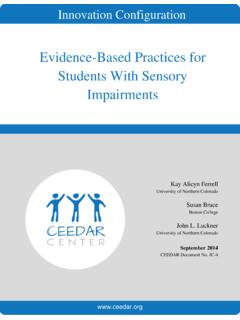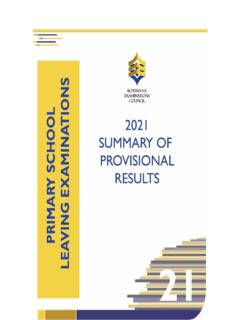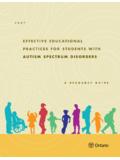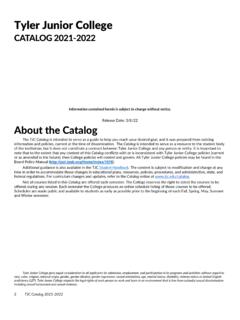Transcription of Pearson BTEC Level 3 Diploma in Healthcare Support
1 Pearson BTEC Level 3 Diploma in Healthcare Support Specification NVQ/Competence-based qualification First registration November 2017 Issue 2 Edexcel, BTEC and LCCI qualifications Edexcel, BTEC and LCCI qualifications are awarded by Pearson , the UK s largest awarding body offering academic and vocational qualifications that are globally recognised and benchmarked. For further information, please visit our qualifications website at Alternatively, you can get in touch with us using the details on our contact us page at About Pearson Pearson is the world's leading learning company, with 35,000 employees in more than 70 countries working to help people of all ages to make measurable progress in their lives through learning. We put the learner at the centre of everything we do, because wherever learning flourishes, so do people. Find out more about how we can help you and your learners at This specification is Issue 2. Key changes are listed in the summary table on the next page.
2 We will inform centres of any changes to this issue. The latest issue can be found on the Pearson website: References to third-party material made in this specification are made in good faith. Pearson does not endorse, approve or accept responsibility for the content of materials, which may be subject to change, or any opinions expressed therein. (Material may include textbooks, journals, magazines and other publications and websites.) All information in this specification is correct at time of publication. ISBN 9781446958605 All the material in this publication is copyright Pearson Education Limited 2018 Summary of specification Issue 2 changes for Pearson BTEC Level 3 Diploma in Healthcare Support Summary of changes made between previous Issue 1 and this current Issue 2 Page number Unit 15: Study Skills for Senior Healthcare Support Workers now appears correctly as mandatory in the qualification structure 7 Guided learning hours for Unit 47: Support individuals during the last days of life now appear correctly in Section 11 of this specification 9 Unit 123: Support individuals to eat and drink, Unit 136: Enable individuals with mental health problems to develop alternative coping strategies and Unit 150: Support children and young people with mental health conditions now appear correctly as optional units in Section 11 of this specification 574, 628, 698 Credit for Unit 153.
3 Anatomy and physiology for maternity Support workers now appears correctly as 2 in Section 11 of this specification 711 In Unit 185: Human Structure and Functionality the Level of the unit now appears correctly as 3 and a wording change has been made to assessment criterion 861-862 In Unit 190: Understand the context of supporting individuals with learning disabilities wording changes have been made to learning outcomes 1, 2, 4 and 6 and to assessment criteria , , , , , , , , , , and Assessment criteria and have been removed. 884-887 Earlier issue(s) show(s) previous changes. If you need further information on these changes or what they mean, contact us via our website at: Contents 1 Introducing Edexcel NVQs/ Competence-based qualifications 1 What are NVQs/Competence-based qualifications? 1 Sizes of NVQs/Competence-based qualifications 1 2 Qualification summary and key information 3 3 Qualification purpose 4 Qualification objectives 4 Relationship with previous qualifications 4 Progression opportunities 5 Industry Support and recognition 5 Relationship with National Occupational Standards 5 4 Qualification structure 6 Pearson BTEC Level 3 Diploma in Healthcare Support 6 5 Programme delivery 18 Elements of good practice 18 Learner recruitment, preparation and Support 18 Training and assessment delivery 19 Employer engagement 19 6 Centre resource requirements 20 General resource requirements 20 7 Access and recruitment 21 Prior knowledge.
4 Skills and understanding 21 Access to qualifications for learners with disabilities or specific needs 21 8 Assessment 22 Language of assessment 22 Internal assessment 22 Assessment requirements 23 Types of evidence 24 Assessment of knowledge and understanding 24 Appeals 25 Dealing with malpractice 25 Reasonable adjustments to assessment 27 Special consideration 28 9 Centre recognition and approval 29 Centre recognition 29 Approvals agreement 29 10 Quality assurance of centres 30 11 Unit format 31 Unit number 31 Unit title 31 Level 31 Unit type 31 Credit value 31 Guided Learning Hours (GLH) 31 Unit summary 31 Unit assessment requirements 31 Learning outcomes 32 Assessment criteria 32 Unit 1: Promote personal development in care settings 33 Unit 2: Safeguarding and protection in care settings 37 Unit 3: Promote health, safety and well-being in care settings 44 Unit 4: Understand mental well-being and mental health promotion 50 Unit 5: Causes and spread of infection 54 Unit 6: Promote communication in care settings 58 Unit 7: Responsibilities of a care worker 62 Unit 8: Promote effective handling of information in care settings 66 Unit 9: Understand mental health problems 69 Unit 10: The principles of infection prevention and control 73 Unit 11: Cleaning, decontamination and waste management 78 Unit 12: Duty of care in care settings 81 Unit 13: Promote equality and inclusion in care settings 84 Unit 14: Promote person-centred approaches in care settings 88 Unit 15: Study Skills for Senior Healthcare Support Workers 94 Unit 16: Understand advance care planning 99 Unit 17: Understand risk management in the paediatric mental health setting 104 Unit 18: Work with babies and young children to Support their development and learning 107 Unit 19: Support individuals who are bereaved 112 Unit 20: Support individuals to access and use information about services and facilities 116 Unit 21.
5 Prepare for and carry out extended feeding techniques 120 Unit 22: Provide Support to individuals to continue recommended therapies 125 Unit 23: Assist in the administration of medication 129 Unit 24: Insert and secure nasogastric tubes 135 Unit 25: Coordinate the progress of individuals through care pathways 140 Unit 26: Undertake personal hygiene activities with individuals 144 Unit 27: Support individuals with speech and language disorders to develop their communication skills 149 Unit 28: Develop positive relationships with children and young people 155 Unit 29: Perform the non-scrubbed circulating role for perioperative procedures 160 Unit 30: Provide advice and information to enable parents to promote the health and well-being of their newborn babies 164 Unit 31: Facilitate and monitor housing and accommodation services to Support individuals with mental health needs 169 Unit 32: Collaborate in the assessment of environmental and social Support in the community 174 Unit 33: Care for the physical and nutritional needs of babies and young children 178 Unit 34: Support individuals to manage their finances 183 Unit 35: Support individuals to carry out their own health care procedures 187 Unit 36: Obtain venous blood samples 191 Unit 37: Implement therapeutic group activities 196 Unit 38: Collate and communicate health information to individuals 200 Unit 39: Provide information and advice to individuals on eating to maintain optimum nutritional status 205 Unit 40: Assist in the implementation of programmes to increase mobility, movement and functional independence 209 Unit 41: Receive and handle clinical specimens within the sterile field 214 Unit 42: Prepare anaesthetic environment and provide Support for pre and post-operative anaesthesia and recovery 218 Unit 43.
6 Make recommendations for the use of physical resources in a health setting 223 Unit 44: Contribute to the discharge of individuals to carers 226 Unit 45: Communicate with individuals about promoting their health and well-being 230 Unit 46: Maintaining quality standards in the health sector 234 Unit 47: Support individuals during the last days of life 238 Unit 48: Assist individuals who have mental health problems when they are transferring between agencies and services 243 Unit 49: Understand mental health and behaviour management of children and young people 247 Unit 50: Promote positive behaviour 251 Unit 51: Support individuals to access and use services and facilities 257 Unit 52: Provide Support for leisure activities 261 Unit 53: Support individuals to meet personal care needs 265 Unit 54: Carry out vision screening 270 Unit 55: Assist professionals to Support individuals from diverse linguistic and cultural backgrounds to access speech and language therapy services 274 Unit 56: Implement hydrotherapy programmes for individuals and groups 279 Unit 57: Deliver exercise sessions to improve individuals health and well-being 283 Unit 58: Contribute to the safe use of medical devices in the perioperative environment 287 Unit 59: Provide Support to the surgical team when preparing individuals for operative and invasive procedures 291 Unit 60: Conduct hearing assessments 295 Unit 61: Support individuals to access education, training or employment 300 Unit 62: Support individuals to access and manage direct payments 305 Unit 63: Work in partnership with families to Support individuals 310 Unit 64: Provide Support for mobility 315 Unit 65: Support individuals to develop and run Support groups 319 Unit 66.
7 Perform first line calibration on clinical equipment to ensure it is fit for use 323 Unit 67: Monitor and review individuals progress in relation to maintaining optimum nutritional status 327 Unit 68: Give presentations to groups 331 Unit 69: Support individuals in undertaking their chosen activities 335 Unit 70: Conduct external ear examinations 340 Unit 71: Control the use of physical resources in a health setting 345 Unit 72: Assist others to plan presentations 348 Unit 73: Support children and young people experiencing transitions 352 Unit 74: Service improvement in the health sector 356 Unit 75: Support individuals to manage their own recovery from mental health problems 359 Unit 76: Understand the process and experience of dementia 362 Unit 77: Move and position individuals in accordance with their care plan 366 Unit 78: Support individuals to manage continence 371 Unit 79: Obtain and test specimens from individuals 375 Unit 80: Undertake urethral catheterisation processes 380 Unit 81: Understand the legal, policy and service framework in mental health 385 Unit 82: Perform routine electrocardiograph (ECG) procedures 389 Unit 83: Prepare individuals for health care activities 394 Unit 84: Undertake treatments and dressings of lesions and wounds 398 Unit 85: Assist in planning and evaluating learning activities 403 Unit 86: Adapt and fit health care equipment, medical devices, assistive technology or products to meet individuals needs 407 Unit 87: Assist the practitioner to carry out health care activities 412 Unit 88: Administer oral nutritional products to individuals 416 Unit 89: Inform an individual of discharge arrangements 421 Unit 90: Supporting individuals with loss and grief before death 425 Unit 91: Support individuals to access housing and accommodation services 429 Unit 92: Provide Support to manage pain and discomfort 434 Unit 93.
8 Select and wear appropriate personal protective equipment for work in health care settings 438 Unit 94: Develop and prepare speech and language therapy resources for alternative and augmentative communication (AAC) use 441 Unit 95: Carry out wound drainage care 445 Unit 96: Monitor and maintain the environment and resources during and after health care activities 450 Unit 97: Prepare and dress for scrubbed clinical roles 454 Unit 98: Prepare and provide surgical instrumentation and supplementary items for the surgical team 458 Unit 99: Care for individuals with naso-gastric tubes 463 Unit 100: Care for a newborn baby 468 Unit 101: Understanding suicide interventions 473 Unit 102: Awareness of the Mental Capacity Act 2005 477 Unit 103: Understand child and young person development 482 Unit 104: Provide Support to maintain and develop skills for everyday life 486 Unit 105: Support individuals who are distressed 490 Unit 106: Facilitate learning and development activities to meet individual needs and preferences 494 Unit 107: Support individuals undergoing health care activities 499 Unit 108: Enable individuals to develop strategies to manage their behaviour 504 Unit 109: Support positive risk taking for individuals 509 Unit 110: Carry out intravenous infusion 514 Unit 111: Reprocess endoscopy equipment 519 Unit 112: Support individuals with cognition or learning difficulties 523 Unit 113: Assist in testing individuals abilities prior to planning physical activities 528 Unit 114: Prepare equipment for intraoperative cell salvage blood processing 533 Unit 115: Assist in receiving, handling and dispatching clinical specimens 538 Unit 116: Support individuals to manage dysphagia 542 Unit 117: Provide advice on foot care for individuals with diabetes 548 Unit 118: Transport, transfer and position individuals and equipment within the perioperative environment 552 Unit 119.
9 Support the spiritual well-being of individuals 557 Unit 120: Managing symptoms in end of life care 561 Unit 121: Recognise indications of substance misuse and refer individuals to specialists 565 Unit 122: Support individuals during a period of change 570 Unit 123: Support individuals to eat and drink 574 Unit 124: Contribute to monitoring the health of individuals affected by health conditions 578 Unit 125: Perform intravenous cannulation 582 Unit 126: Care for individuals with urethral catheters 587 Unit 127: Conduct routine maintenance on clinical equipment 592 Unit 128: Assist and Support individuals to use alternative and augmentative communication (AAC) systems 597 Unit 129: Measure and record individuals body fluid balance in a perioperative environment 602 Unit 130: Prepare and apply dressings and drains to individuals in the perioperative environment 606 Unit 131: Support parents or carers to interact with and care for their newborn baby 611 Unit 132: Deliver training through demonstration and instruction 616 Unit 133: Support individuals during emergency situations 620 Unit 134: Principles of health promotion 624 Unit 135: Promotion of general health and well-being 626 Unit 136: Enable individuals with mental health problems to develop alternative coping strategies 628 Unit 137: Support child and you
















